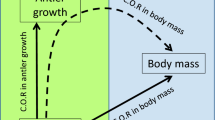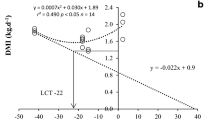Abstract
We analysed intercohort variability of live weight and antler length of 5,123 reindeer calves. We further assessed the influence of climate and density on the interannual variation in antler length, and discussed sex-specific resource allocation and response to climate variability. Antler length varied significantly among years and between sexes, with interaction between year and sex. Body weight and antler length were highly positively correlated, showed similar intercohort variability, and had a strong allometrical link, suggesting that antler length could be an equally reliable measure of calf condition as live weight. We found a relative measure of antler length (i.e. antler length corrected for the allometric effect of body mass) to be positively influenced by increasing density and May–June precipitation, and also decreasing May–June temperature. We attributed the effect of early summer weather to its influence on forage availability and quality as well as the level of parasitic insect harassment. Gender difference in both the allometric exponents and the interannual variability suggest that young males and females may have different tactics for relative resource allocation towards growth of antlers as compared to body mass. Because antlers are costly to produce, they may be an honest signal of individual quality for both sexes. However, we found gender-specific allometry, as female calves more than males appear to prioritize their antler growth over body mass, especially when resources are limited. Thus, our results suggest that environmental variation may influence the extent of sexual dimorphism in antler length.



Similar content being viewed by others
References
Adams LG, Dale BW (1998) Reproductive performance of female Alaskan Caribou. J Wildl Manage 62:1184–1195
Albon SD, Clutton-Brock TH, Langvatn R (1992) Cohort variation in reproduction and survival: implications for population demography. In: Brown RD (ed) The biology of deer. Springer, Berlin Heidelberg New York, pp 15–21
Andersson M (1994) Sexual selection. Princeton University Press, Princeton
Barrette C, Vandal D (1985) Social rank, dominance, antler size, and access to food in snow-bound wild woodland caribou. Behaviour 97:118–146
Blake JE, Rowell JE, Suttie JM (1998) Characteristics of first-antler growth in reindeer and their association with seasonal fluctuations in steroid and insulin-like growth factor 1 levels. Can J Zool 76:2096–2102
Calder WA (1996) Size, function, and life history. Dover Publication Inc., Mineola
Clutton-Brock TH (1982) The function of antlers. Behaviour 79:108–125
Clutton-Brock TH, Guinness FE, Albon SD (1982) Red deer: behavior and ecology of the two sexes. University of Chicago Press, Chicago
Colman JE, Pedersen C, Hjermann D, Holand Ø, Moe SR, Reimers E (2002) Do wild reindeer exhibit grazing compensation during insect harassment? J Wildl Manage 67:11–19
Coltman DW, O’Donoghue P, Jorgenson JT, Hogg JT, Strobeck C, Festa-Bianchet M (2003) Undesirable evolutionary consequences of trophy hunting. Nature 426:655–658
Ditchkoff SS, Lochmiller RL, Masters RE, Hoofer SR, van den Bussche R (2001) Major-histocompatibility-complex-associated variation in secondary sexual traits of white-tailed deer (Odocoileus virginianus): evidence for good-genes advertisement. Evolution 55:616–625
Espmark Y (1964) Rutting behaviour in reindeer (Rangifer tarandus L.). Anim Behav 12:159–163
Espmark Y (1971) Antler shedding in relation to parturition in female reindeer. J Wild Manage 35:175–177
Festa-Bianchet M, Coltman DW, Turelli L, Jorgenson JT (2004) Relative allocation to horn and body growth in bighorn rams varies with resource availability. Behav Ecol 15:305–312
Finstad GL, Prichard AK (2000) Growth and body weight of free-range reindeer in western Alaska. Rangifer 20:221–227
Forchhammer MC, Clutton-Brock TH, Lindström J, Albon SD (2001) Climate and population density induce long-term cohort variation in a northern ungulate. J Anim Ecol 70:721–729
Fowler CW (1987) A review of density dependence in populations of large mammals. Curr Mammal 1:401–441
Gaillard J-M, Festa-Bianchet M, Yoccoz NG, Loison A, Toïgo C (2000) Temporal variation in fitness components and population dynamics of large herbivores. Annu Rev Ecol Syst 31:367–393
Gaillard J-M, Loison A, Toïgo C, Delorme D, Van Laere G (2003) Cohort effects and deer population dynamics. Ecoscience 10:312–320
Giacometti M, Willing R, Defila C (2002) Ambient temperature in spring affects horn growth in male alpine ibexes. J Mammal 83:245–251
Hewison AJM, Gaillard JM (2001) Phenotypic quality and senescence affect different components of reproductive output in roe deer. J Anim Ecol 70:600–608
Hjeljord O, Histøl T (1999) Range-body mass interactions of a northern ungulate—a test of hypothesis. Oecologia 119:326–339
Holand Ø, Gjøstein H, Losvar A, Kumpula J, Smith ME, Røed KH, Nieminen M, Weladji RB (2004) Social rank in female reindeer (Rangifer tarandus): effects of body mass, antler size and age. J Zool 263:365–372
Huxley JS (1932) Problems of relative growth. Methuen, London
Jonasson OW, Bryant JP, Stuart Chapin FS III, Andersson M (1986) Plant phenols and nutrients in relation to variations in climate and rodent grazing. Am Nat 128:394–408
Jurïsson T, Raave L (1984) Influence of climatic conditions on the yield and quality of grassland in Estonia. In: Riley H, Skjelvåg AO (eds) The impact of climate on grass production and quality. Proceedings of the 10th general meeting of the European grassland federation, Å s-Norway, 26–30 June 1984, pp 339–350
Kokko H (1997) Evolutionary stable strategies of age-dependent sexual advertisement. Behav Ecol Sociobiol 41:99–107
Laine KM, Henttonen H (1987) Phenolics/nitrogen ratios in the blueberry Vaccinium myrtillus in relation to temperature and microtine density in Finnish Lapland. Oikos 50:389–395
Langvatn R, Albon SD, Burkey T, Clutton-Brock TH (1996) Climate, plant phenology and variation in age at first reproduction in a temperate herbivore. J Anim Ecol 65:653–670
Leblanc M, Festa-Bianchet M, Jorgenson JT (2001) Sexual dimorphism in bighorn sheep (Ovis canadensis): effects of population density. Can J Zool 79:1661–1670
Levene H (1960) Robust tests for the equality of variance. In: Olkin I (ed) Contributions to probability and statistics. Stanford University Press, Palo Alto, pp 278–292
Littell RC, Milliken GA, Stroup WW, Wolfinger RD (1996) SAS system for mixed models. SAS Institute Inc., Cary
Loison A, Langvatn R, Solberg EJ (1999) Body mass and winter mortality in red deer calves: disentangling sex and climate effects. Ecography 22:20–30
Markusson E, Folstad I (1997) Reindeer antlers: visual indicators of individual quality? Oecologia 110:501–507
Post E, Stenseth NC (1999) Climatic variability, plant phenology, and northern ungulates. Ecology 80:1322–1339
Post E, Langvatn R, Forchhammer MC, Stenseth NC (1999) Environmental variation shapes sexual dimorphism in red deer. Proc Natl Acad Sci USA 96:4467–4471
Prichard AK, Finstad GL, Shain DH (1999) Factors affecting velvet antler weights in free-ranging reindeer in Alaska. Rangifer 19:71–76
Putman RJ, Langbein J, Hewison AJM, Sharma SK (1996) Relative roles of density-dependent and density-independent factors in population dynamics of British deer. Mamm Rev 26:81–101
Rasmussen GP (1985) Antler measurements as an index to physical condition and range quality with respect to white-tailed deer. NY Fish Game J 32:97–113
Reimers E (1993) Antlerless females among reindeer and caribou. Can J Zool 71:1319–1325
Reimers E, Klein DR, Sørumgård R (1983) Calving time, growth rate and body size of Norwegian reindeer on different ranges. Arctic Alp Res 15:107–118
Reindriftsforvaltningen (1998) Ressursregnskap for reindriftsnæringen. Reindriftsforvaltningen. Alta, Norge (Report in Norwegian)
Sæther BE (1997) Environmental stochasticity and population dynamics of large herbivores: a search for mechanisms. Trends Ecol Evol 12:143–149
Sæther BE, Andersen R, Hjeljord O, Heim M (1996) Ecological correlates of regional variation in life history of a large herbivore, the moose Alces alces. Ecology 77:1493–1500
SAS Institute Inc (1999) The SAS system for Windows, release 8.01. SAS Inst. Inc., Cary, NC, USA
Schmidt KT, Stien A, Albon SD, Guinness FE (2001) Antler length of yearling red deer is determined by population density, weather and early life-history. Oecologia 127:191–197
Scribner KT, Smith MH, Johns PE (1989) Environmental and genetic components of antler growth in white-tailed deer. J Mammal 70:284–291
Skogland T (1983) The effect of density dependent resource limitation on size of wild reindeer. Oecologia 60:156–168
Skogland T (1984) The effects of food and maternal condition on fetal growth and size in wild reindeer. Rangifer 4:39–46
Skogland T (1989) Comparative social organisation of wild reindeer in relation to food, mates and predator avoidance. Z Tierpsychol [Suppl] Advances in ethology, vol 29. Parey, Berlin
Solberg EJ, Sæther BE (1993) Fluctuating asymmetry in the antlers of moose (Alces alces)—does it signal male quality? Proc R Soc Lond Ser B 254:251–255
Solberg EJ, Loison A, Gaillard J-M, Heim M (2004) Lasting effects of conditions at birth on moose body mass. Ecography 27:677–687
Stenseth NC, Mysterud A, Ottersen O, Hurrell JW, Chan KS, Lima M (2002) Ecological effects of climate fluctuations. Science 297:1292–1296
Suttie JM, Kay RNB (1982) The influence of nutrition and photoperiod on growth of antlers of young red deer. In: Brown RD (ed) Antler development in Cervidae. Caesar Kleberg Wildlife Research Institute, Kingsville, pp 61–71
Suttie JM, Webster JR (1998) Are arctic ungulates physiologically unique? Rangifer 18:99–118
Toïgo C, Gaillard J-M, Michallet J (1999) Cohort affects growth of males but not of females in alpine ibex (Capra ibex ibex). J Mammal 80:1021–1027
Ullrey DE (1982) Nutrition and antler development in white-tailed deer. In: Brown RD (ed) Antler development in Cervidae. Caesar Kleberg Wildlife Research Institute, Kingsville, pp 49–59
Von Hardenberg A, Bassano B, Aranz Md-PZ, Bogliani G (2004) Horn growth but not asymmetry heralds the onset of senescence in male Alpine ibex (Capra ibex). J Zool 263:425–432
Weladji RB (2003) Climatic Influences on the Life History and Population Dynamics of a Northern Ungulate, Rangifer tarandus. PhD Thesis, Agricultural University of Norway
Weladji RB, Holand Ø (2003a) Global climate change and reindeer: effects of winter weather on the autumn weight and growth of calves. Oecologia 136:317–323
Weladji RB, Holand Ø (2003b) Sex ratio variation in reindeer: a test of the extrinsic modification hypothesis. Wildl Biol 9:29–36
Weladji RB, Klein DR, Holand Ø, Mysterud A (2002) Comparative response of reindeer/caribou and other northern ungulates to climatic variability. Rangifer 22:33–50
Weladji RB, Holand Ø, Almøy T (2003) Use of climatic data to assess the effect of insect harassment on the autumn weight of reindeer (Rangifer tarandus) calves. J Zool 260:79–85
Wika M (1980) On the growth of reindeer antlers. In: Reimers E, Gaare E, Skjennberg S (eds) Proceedings of the 2nd international Reindeer/Caribou symposium, Røros, Norway, 1979. Direktoratet for vilt og ferskvannsfisk, Trondheim, pp 416–442
Acknowledgements
We gratefully acknowledge the financial support of the Norwegian Reindeer Husbandry Development Fund. Tove S.K. Skaget of the Nord Trøndelag reindeer area has been helpful throughout with organizing the data. RBW was supported by a grant from the Norwegian Research Council. The handling and weighing regime of animals in this study was done in accordance with regulations set by the Norwegian Animal Welfare Act.
Author information
Authors and Affiliations
Corresponding author
Additional information
Communicated by Roland Brandl
Electronic supplementary material
Rights and permissions
About this article
Cite this article
Weladji, R.B., Holand, Ø., Steinheim, G. et al. Sexual dimorphism and intercorhort variation in reindeer calf antler length is associated with density and weather. Oecologia 145, 549–555 (2005). https://doi.org/10.1007/s00442-005-0155-8
Received:
Accepted:
Published:
Issue Date:
DOI: https://doi.org/10.1007/s00442-005-0155-8




